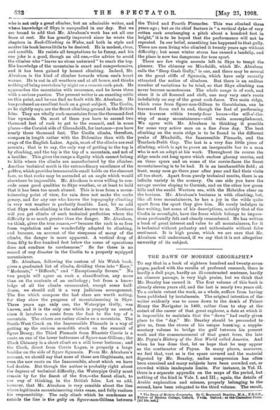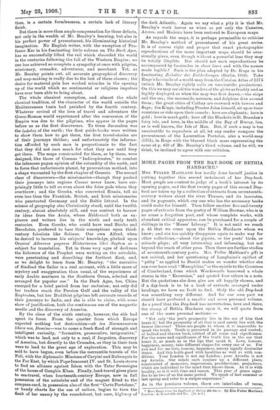THE DAWN OF MODERN GEOGRAPHY.*
To say that in a book of eighteen hundred and twenty-sevew pages, packed. with the results of profound research, there is hardly a dull page, hardly an ill-constructed sentence, hardly- an obscure passage, is very high praise, but we think that Mr. Beazley has earned it. The first volume of this-book is- already eleven years old, and the last is nearly two years old. To a certain extent the work, as a whole, suffers from having been published by instalments. The original intention of the•• writer evidently was to come down to the death of Prince Henry the Navigator in 1460, rather than to stop at the- outset of the career of that great explorer, a date at which it is impossible to maintain that the " dawn " had really given place to the " day." Mr. Beasley should be persuaded to- give us, from the stores of his unique learning, a supple- mentary volume to bridge the gulf between his present work and the commencement of that great torso, the late Mr. Payne's History of the New World called America. And when he has done that, let us hope that he may appear as the continuator of Payne. In many places, moreover, . we feel that, vast as is the space covered and the material digested by Mr. Beazley, undue compression- has often been exercised and many- subjects have been crowded out, or • crowded within inadequate limits. For instance, in Vol. II. there is a separate appendix on the maps of the period, but . nothing of the kind in Vols. L and M.; again, the details of Arabic exploration and science, properly belonging to the- second, have been relegated to the third volume. The result, .
• The Dawn of Modern Geography. By C. Raymond Beasley, M.A., F.B.G.S.,. Fellow of Merton College, Oxford, S vole. Oxford: at the Clarendon Press. . [£.2 10e. net.]
then, is a certain formlessness, a certain lack of literary finish.
But there is more than ample compensation for these defects, not only in the wealth of Mr. Beazley's learning, but also in his perfect power of presentment, his illuminating historical imagination. No English writer, with the exception of Pro- fessor Ker in his fascinating little volume on The Dark Ages, has so successfully lifted the veil which shrouded the world in the centuries following the fall of the Western Empire; no one has achieved so complete a sympathy at once with pilgrim, missionary, crusader, adventurer, and merchant. Yet, as Mr. Beazley points out, all accurate geographical discovery and map-making is really due to the last of these classes ; the desire for material gain has worked miracles in the opening up of. the world which no sentimental or religious impulses have ever been able to bring about.
The whole classical conception, and almost the whole classical tradition, of the character of the world outside the Mediterranean basin had perished by the fourth century. Whatever revival of the love of travel and adventure the Greco-Roman world experienced after the conversion of the Empire was due to the pilgrims, who appear in the pages before us as the first discoverers. To them Jerusalem was the CenpaXcis of the earth ; the first guide-books were written to show them how to get there, the first travel-stories are of their journeys thither; and unfortunately the informa- tion afforded by such men is proportionate to the fact that they did not Care much for what they saw until they got there. The maps constructed for them, or by them, were designed, like those of Cosmas " Indicopleustes," to combat the infamous pagan opinion of the rotundity of the earth, and to force that unfortunate planet, by procrustean method, into a shape warranted by the first chapter of Genesis. The second class of discoverers—the missionaries—though they pushed their journeys into regions Caesar never knew, have sur- prisingly little to tell us even about the false gods whom they overthrew ; and the Greeks, who converted Russia, tell us even less than the Frankish, British, and Irish missionaries who penetrated Germany and the Baltic littoral. In the science of geography also Christianity stood, until the twelfth century, almbst absolutely still, and was content to borrow its ideas from the Arabs, whose Heldenzeit both as ex- plorers and writers lies in the ninth and early tenth centuries. Even Greeks, who could have read Strabo and Herodotus, preferred to base their conceptions upon third- century fabulists like Solinus. Our own Alfred, when he desired to increase his subjects' knowledge, pitched upon Orosius' Adverszts paganos Historiaruns libri Septem as a subject for translation. Yet in those very ages of darkness the followers of the Prophet were writing on the astrolabe, were penetrating and describing the furthest East, and, as we delight to learn from Mr. Beazley, " the narrative of Sindbad the Sailor is a real account, with a little more of mystery and exaggeration than usual, of the experiences of early Arabic mariners in the Southern Ocean, selected and arranged for popular use." In the Dark Ages, too, China emerged for a brief period from her seclusion; not only did her traders reach the Persian Gulf and the valley of the Euphrates, but her Buddhist pilgrims left accurate records of their journeys to India, and she is able to claim, with some show of justification, both the continuous use of the magnetic needle and the discovery of America.
By the close of the ninth century, however, the ebb had spent its force. From the quarter from which Europe expected nothing but destruction—ab Ara Normannorunt libera nos, Domine—was to come a fresh flood of strength and intelligent curiosity, " formative, provocative, invigorative," which was to lead, not only to a real, if forgotten, discovery of America, but directly to the Crusades, as they in their turn were to lead to the great age of exploration. This may be said to have begun, even before the mercantile travels of the Poli, with the diplomatic Missions of Carpini and Rubruquis to the Far East, by which Pope-Innocent IV. and St. Louis strove to find an alliance against Islam with the Tatar Sovereigns of the house of Genghis Khan. Finally, land-travel gives place to sea-travel, when fourteenth-century Europe, now in full possession of the astrolabe and of the magnet fitted to the compass-card, in possession also of the first" Carte Portolane," or handy charts for the use of sailors, begins to turn the flank of her enemy by the roundabout, but sure, highway of
the dark Atlantic. Again we say what a pity it is that Mr. Beazley's work leaves us when as yet only the Canaries, Azores, and Madeira have been restored to European maps.
As regards the maps, it is perhaps permissible to criticise Mr. Beazley's method of presentment of his great series. It is of course right and proper that exact photographic reproductions of the more important maps should be occa- sionally given, even though without a powerful lens they may be totally illegible. But should not such reproductions be accompanied by facsimiles in clear lines and with the names made legible ? Such is the plan adopted by Dr. Ruge in his fascinating Zeitalter der Eatdeckungen (Berlin, 1881). Take Ruge's facsimile of a world-map from the Catalan Atlas of 1375 (which Mr. Beazley rightly calls an unscientific production). On this we may see all the wonders of the globe as freshly and as legibly displayed as when the map was first drawn,—the ships sail the sea; the mermaids, mermen, and dolphins dive around them ; the great cities of Cathay are crowned with towers and flags; the Kings, including Prester John himself, sit upon their countries or ride upon their camels : here are elephants ; here is gold ; here is much gold ; here off the Blaskets is St. Brendan's fairy isle, and here, in the middle of the Bay of Biscay, lies. as is well known, the Isle of Man. But, if such a map is too unscientific to reproduce at all, let any reader compare the presentment of the Laurentian Portolan, also a world-map (1351), in Ruge with the blurred black mass representing the same at p. 439 of Mr. Beazley's third volume, and he will, we think, be inclined to agree with our criticism.







































 Previous page
Previous page